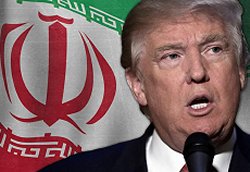
|
- Iran: Eight Prisoners Hanged on Drug Charges
- Daughter of late Iranian president jailed for ‘spreading lies’ - IRAN: Annual report on the death penalty 2016 - Taheri Facing the Death Penalty Again - Dedicated team seeking return of missing agent in Iran - Iran Arrests 2, Seizes Bibles During Catholic Crackdown
- Trump to welcome Netanyahu as Palestinians fear U.S. shift
- Details of Iran nuclear deal still secret as US-Tehran relations unravel - Will Trump's Next Iran Sanctions Target China's Banks? - Don’t ‘tear up’ the Iran deal. Let it fail on its own. - Iran Has Changed, But For The Worse - Iran nuclear deal ‘on life support,’ Priebus says
- Female Activist Criticizes Rouhani’s Failure to Protect Citizens
- Iran’s 1st female bodybuilder tells her story - Iranian lady becomes a Dollar Millionaire on Valentine’s Day - Two women arrested after being filmed riding motorbike in Iran - 43,000 Cases of Child Marriage in Iran - Woman Investigating Clinton Foundation Child Trafficking KILLED!
- Senior Senators, ex-US officials urge firm policy on Iran
- In backing Syria's Assad, Russia looks to outdo Iran - Six out of 10 People in France ‘Don’t Feel Safe Anywhere’ - The liberal narrative is in denial about Iran - Netanyahu urges Putin to block Iranian power corridor - Iran Poses ‘Greatest Long Term Threat’ To Mid-East Security |
Friday 10 October 2008Residents of Bushehr, do you feel safe?http://anucleardisaster.blogspot.com/ On 8 September, there were several earthquakes in southern Iran. In one instance, the earthquake shook the entire Hourmozegan province so much that residents of Bandar Abbas, Kasham, Minab, and other cities in the area left their houses and fled for their lives. These were relatively weak earthquakes, but Iran is known to be located in one of the most earthquake prone areas on earth, and the Bushehr area, where the reactor has been built, is considered a particularly problematic seismological area. Another earthquake, after the reactor is commissioned, could lead to disaster of international proportions. The Bushehr nuclear reactor is only 12 kilometers from the city of Bushehr and its 180,000 residents. Given this fact, and others that will be presented below, we would like to bring to the attention of the citizens the multiple dangers related to commissioning the reactor. Characteristics of the Bushehr Reactors The reactors being built in Bushehr have a high energy output. They work at extremely high temperature and pressure which accelerates material corrosion. A known weak point is a failure in the steam generators, which can lead to radioactive leakage out of the system containment shell and in worse cases, to even more serious accidents. Cracks frequently form in the reactor tank cover, and since the system also produces hydrogen, this can lead to an explosion. This type of reactor depends more heavily on safety systems, which rely on a constant electricity supply. Emergency systems, especially backup electricity supply, must be absolutely reliable (and this is not always the case) especially relating to their ability to withstand natural disasters, such as earthquakes, floods, and storms. Potential Dangers Although the IAEA has determined standards for safe transfer of nuclear materials, in practice these standards are simply not relevant to the conditions in case of an accident. For example, spent fuel tanks are supposed to be able to resist a fall of only 9 meters, and withstand temperatures of 800 degrees for up to 30 minutes. Research shows that in case of an accident, fires last far longer than 30 minutes and temperatures rise well beyond 800 degrees. Any plane crash will undoubtedly involve a fall of more than 9 meters. Waste Storage Waste storage will continue to pose great dangers, since the plant produces large amounts of waste. The chemical/toxic threat of uranium distribution into the atmosphere is a real one. As in the case of Esfahan, an explosion resulting in scattering of uranium stored at the site will be highly toxic to the population surrounding the plant, will cause damage to internal organs (especially the kidneys), and will increase the risk of cancer. Earthquakes As is known, the reactor base was designed in the 1970’s. Even if the design was reasonable for its time, international standards for constructing reactors in problematic seismologic areas have since become far more stringent. In addition, the reactor was actually built with Russian technology by Russia, which is known not to place a very high premium on safety issues. Source of Radioactive Material Until the reactor’s activation, the 80 tons of uranium fuel that were supplied to the site will pose a serious chemical and radiological threat. As soon as the reactor begins working, Bushehr will become a huge source of radioactive emissions in the whole area. This danger will reach a maximum after three years of activity. Military Attack Given the concern of the free world over Iran’s nuclear program, there is a very real danger of military attack. In Summary After the site becomes active, Bushehr will be the single greatest source emitting radioactivity in the area, with the potential to release a similar or even higher level than was released in a serious accident, such as Chernobyl. This danger will be relevant starting from the third year of site activity. In the event of serious damage to the reactor and its containment shell, people will have to sit in shelters, and perhaps even be evacuated downwind to a distance of about 150 kilometers, depending on atmospheric conditions. If there is a large scale incident, nearby countries, such as Qatar, Saudi Arabia, Kuwait, and the UAE, will have to take steps to protect their populations from radiation exposure. |

 Send to a Friend
Send to a Friend
